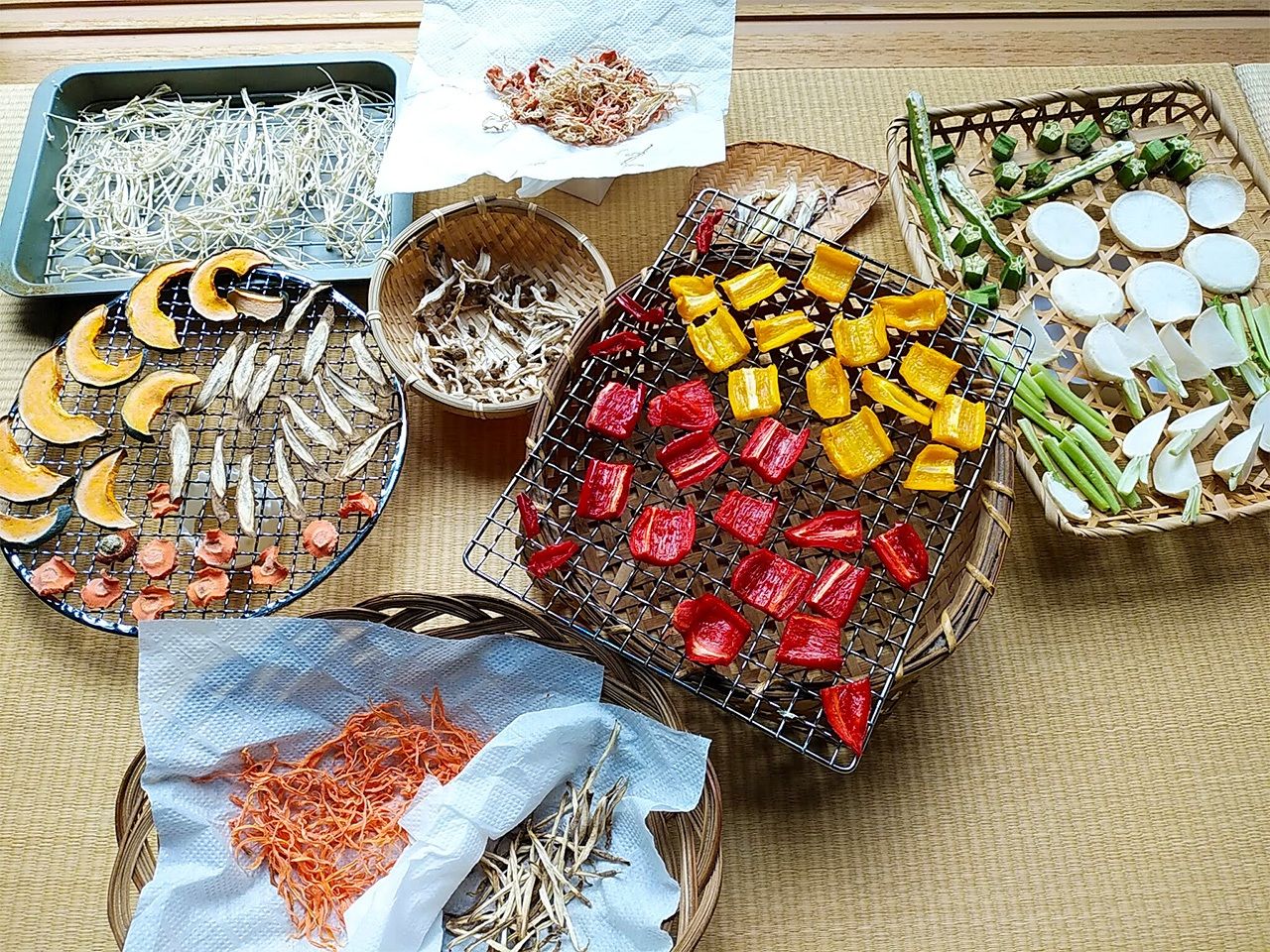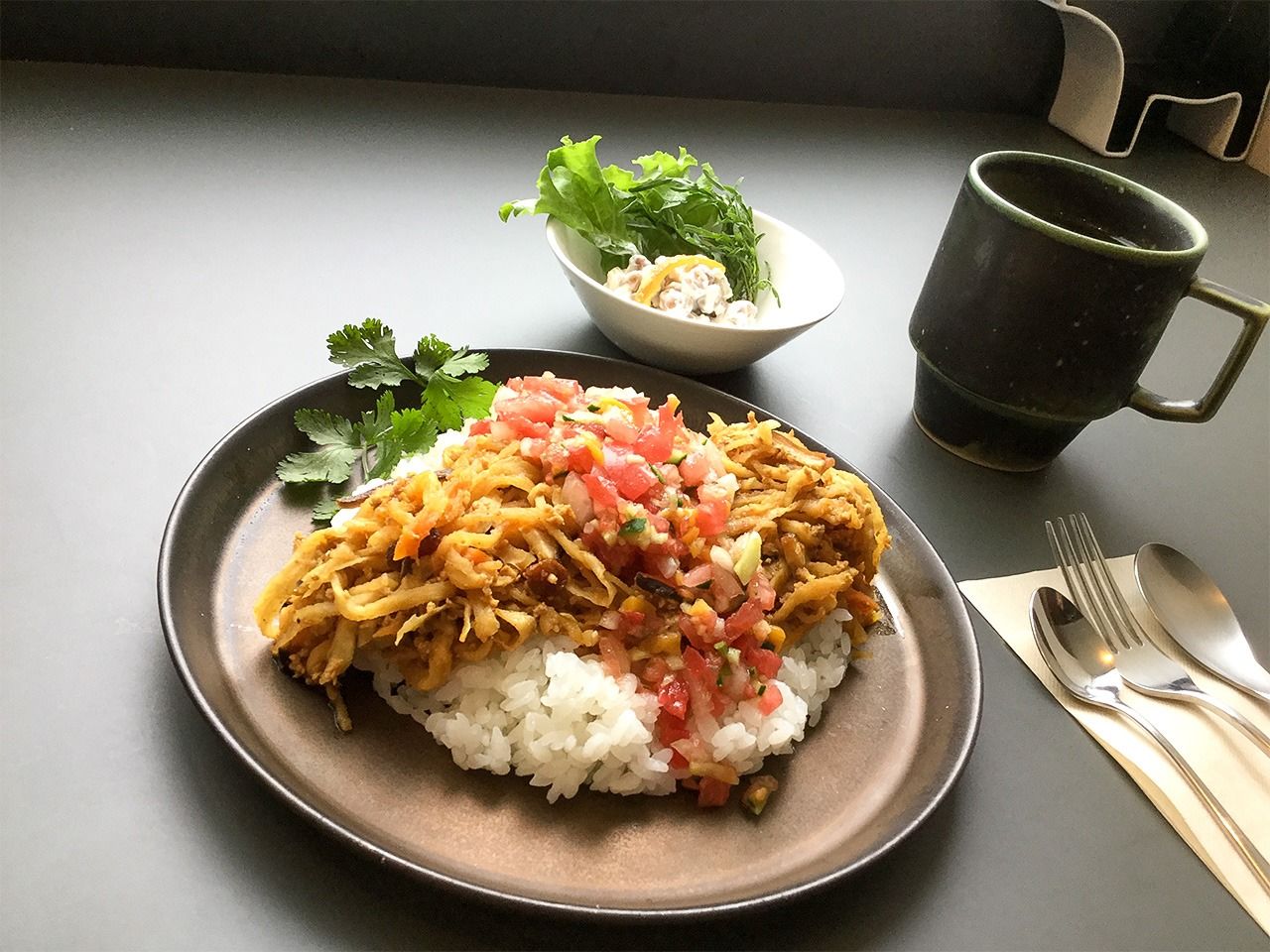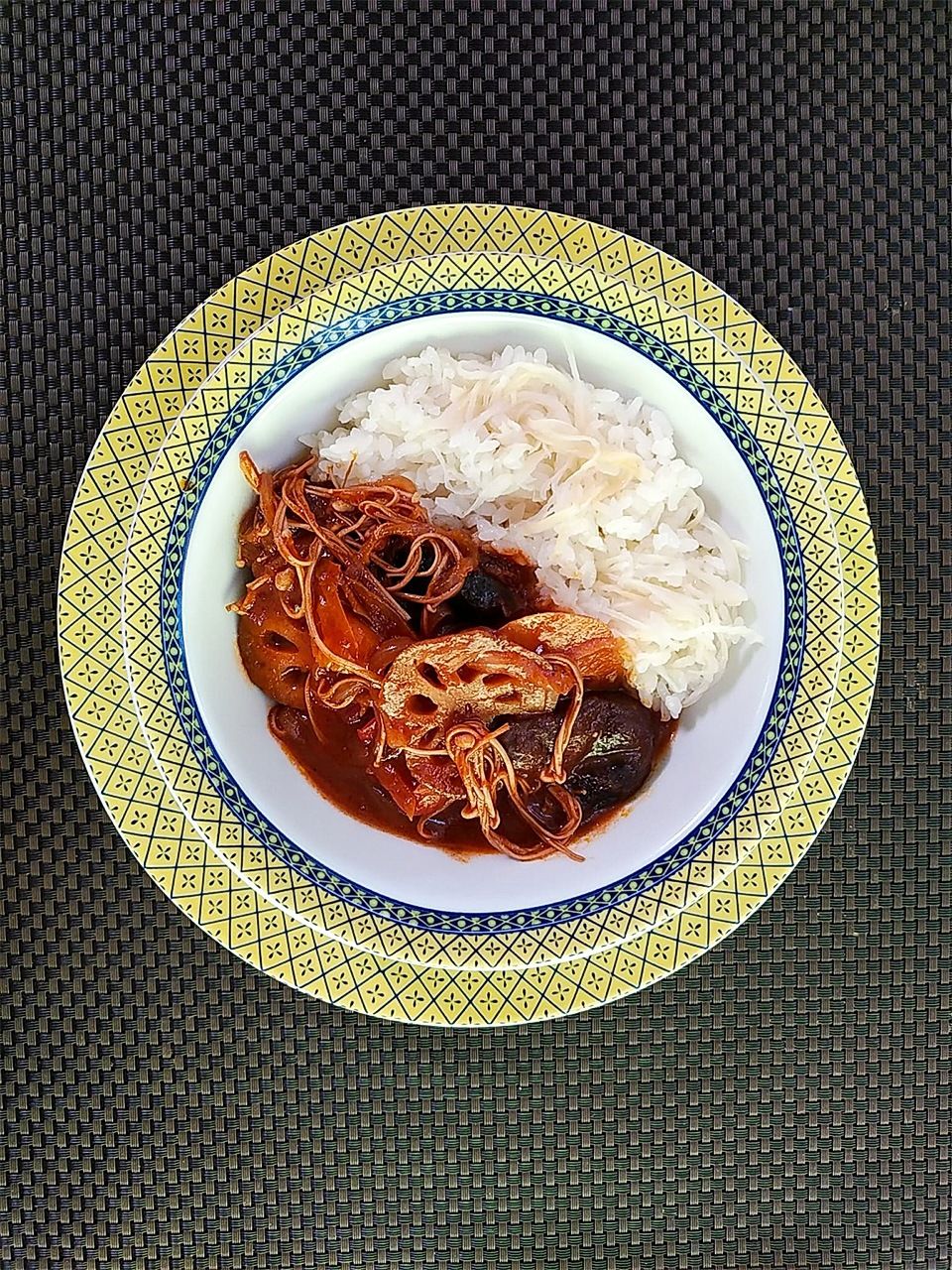Dried foods, or kanbutsu, are key ingredients for traditional home cooking in Japan, and are used for everyday life by millions of people around the country. Cooking with kanbutsu has the potential to go far beyond these standards. Sakai Yukako writes about new possibilities for kanbutsu, encouraging exploration of innovative and creative potential beyond the traditional ways.
From Japan to Milan
In 2015, DRY and PEACE held an event over three days on “The Future of Kanbutsu” in Milan, where an international food expo was held.
We put on displays and workshops to introduce visitors to Japanese kanbutsu—traditional dried food used in the country’s cuisine—and their new significance in contemporary Japanese life. We also demonstrated some of the techniques to cook traditional kanbutsu and gave people a chance to learn how to dry vegetables at home, as well as offering free tastings of dishes using these dried treats as one of the main ingredients. European-style fusion dishes made with traditional kanbutsu like niboshi (dried sardines) and kōya-dōfu (freeze-dried tofu) proved a big hit, with many people rejoining the line for second servings.

Our kanbutsu workshop in Milan was a major success.
One woman who attended on the first day of the event came again on the final day with her children, eager for them to learn an important lesson: “These kanbutsu are really amazing,” she enthused. “If you dry vegetables like this at home you will never waste any food.” One man was so impressed he came up to shake my hand, saying he wanted to express his thanks for “having come all this way to introduce us to this wonderful culture.” The event was also covered in Il Giornale, a major Italian newspaper.
Interestingly, the enthusiastic reactions of Italian visitors helped to open the eyes of local Japanese residents to the wider possibilities of kanbutsu. Several people I spoke to said the workshop had made them realize that “maybe we’ve been too fixed on preconceived ideas of kanbutsu.”
The truth is that many people in Japan still think of kanbutsu as outdated. However, it’s time to revisit how we use dried foods!
The Last Things Left by Panic Buyers
My own awakening to the wider potential of kanbutsu dates to 2011. Around then I started developing new recipes fit for people’s busy daily life and changes in diet, working to publish my cookbooks.
Not long after that, the Great East Japan Earthquake and tsunami occurred. In the area where I lived, planned power outages were carried out to cover for the power shortage after the nuclear power station accident in Fukushima. Even though refrigerators at home were no use for several hours a day, fresh foods were all sold out at supermarkets. However, kanbutsu were there, just as usual. Kanbutsu would keep for months without refrigeration, making them an ideal food in those circumstances.
Perhaps most of the people didn’t realize that they could use kanbutsu even though they don’t have refrigeration. Or maybe they were simply not used to cooking with kanbutsu. Whatever the reason, I found kanbutsu apparently overlooked by the crowds of frenzied shoppers.
In the days before refrigeration, kanbutsu were vital as they would keep for long time at room temperature. They could often be essential for survival in a country like Japan, where many regions experience harsh winters with heavy snowfall, and natural disasters have often brought crop failures and famine. People dried foodstuffs at harvest time and preserved them.
Kanbutsu can be considered as a major pillar of Japanese food culture. In the days before refrigerated food transport, people living in inland areas would experience seafood in a dried form as kanbutsu. Even rice, the national staple, is dried for preservation.
Importantly, in Japanese food culture kanbutsu are meant to do more than just preserve food. Kanbutsu products often transform the original ingredients into new tastes, textures, and forms.
Moreover, umami has been attracting global attention in recent years and is a major taste component for Japanese cuisine. Dashi, the basic broth for many kind of Japanese dish, is made from dried food like konbu (kelp), katsuobushi (dried bonito), niboshi (dried anchovy), and shiitake mushrooms.
Why Kanbutsu Now?
For generations, people in Japan have made kanbutsu, mainly for the purpose of preserving precious food. Considering kanbutsu from the perspective of contemporary society brings new aspects of this style of food preparation into new focus.
• Reducing Food Loss
As kanbutsu can be preserved for a long time, for six months or even more, using these items can reduce food loss and waste.
Supermarkets often reject vegetables and other fresh foods on cosmetic grounds like shape. These have nothing to do with flavor or nutritional value. Making kanbutsu from these rejected vegetables means they can be turned into commercially viable food products that can be sold and used throughout the year.
• Saving Energy
Kanbutsu are low in weight. This can help to reduce the amount of carbon dioxide emitted during shipping. And since they do not need to be refrigerated, kanbutsu can help further to reduce electricity consumption.
• Emergency Supplies
Kanbutsu are the ideal foods to keep on hand in case of blackout, as they can be kept at room temperature.
• Reduced Workload in the Home
Kanbutsu are light and easy to handle, making shopping lighter. Vegetables are peeled and cut for ready to use; they only need to be soaked in water. And using kanbutsu avoids raw waste and smelly garbage.
• Safe to Eat
Kanbutsu are preserved naturally, by drying, and no artificial preservatives are needed. All the ingredients are familiar and clearly labeled, allowing people with allergies to eat without worries.
Making Kanbutsu at Home
Japan experiences natural disasters almost every year, either in the form of major floods or earthquakes. I believe that these frequent disasters, not to mention the coronavirus pandemic that has rocked the world in 2020, have changed the way many people think about kanbutsu.
Many people have told me that drying vegetables at home became a regular part of their daily routine during the COVID-19 crisis, when the government was urging people to stay home. Others say the crisis brought home to them how useful traditional kanbutsu and dried vegetables can be and gave them a new appreciation for these ingredients. Many people who have attended our DRY and PEACE kanbutsu workshops say that despite all the stress of recent events, food is one thing they do not have to worry about, since they now know how to dry vegetables at home and how to use both traditional kanbutsu and the vegetables they prepare.
Back when we were planning for our event in Milan, I realized that it wasn’t easy to get Japanese kanbutsu at local stores in Italy. I knew that if our event merely introduced participants to Japanese kanbutsu, it would have a limited impact on their daily lives. People might enjoy being introduced to an interesting aspect of Japanese culture, but that would be the end of it. What I really wanted to get across to people was that many foods in their own culture could also be regarded as kanbutsu—dried tomatoes and porcini mushrooms, for example, along with many types of beans, nuts, dried fruits, and even pasta. I wanted to show them how easy it was to make their own kanbutsu themselves at home, as well.
To achieve this, we decided to incorporate a workshop into the event, where participants would be able to try the techniques of drying vegetables themselves.
Even if people like the idea of eating lots of different vegetables, it’s not always realistic when cooking at home for relatively small numbers of people, and food often goes to waste. But once you get into the habit of drying vegetables at home, it’s very easy, economical, healthy, and delicious. This makes it simple to incorporate a wide diversity of vegetables into your diet, at the same time reducing vegetable food waste and leading to a lifestyle that is more economical and eco-friendly.
No special tools are necessary. All you need to do is chop your vegetables and put them out to dry. Some vegetables like eggplant and burdock should be soaked in cold water before drying to remove their astringent flavor. Leaf vegetables, cruciferous vegetables like broccoli and cauliflower, and produce like string beans and green peas should be blanched in boiling water before drying. Blanching speeds up the drying process.

Kanbutsu can be made indoors, too. Top row, from left: enoki mushrooms, carrots, and daikon mix. Middle at left: pumpkin, carrots, and burdock; shimeji mushrooms; myōga ginger bulbs. Diagonally from bottom to right: carrots and burdock; bell peppers; and turnip slices with okra.
Kanbutsu can be made indoors, too. Top row, from left: enoki mushrooms, carrots, and daikon mix. Middle at left: pumpkin, carrots, and burdock; shimeji mushrooms; myōga ginger bulbs. Diagonally from bottom to right: carrots and burdock; bell peppers; and turnip slices with okra.
It’s not necessary to dry your vegetables outdoors; it can even be done inside the house. There are just a few simple guidelines to follow.
Cut the vegetables small and fine, to maximize the area that is exposed to the air, and take care when putting them out to dry so that they do not overlap. Make sure to start the process on a dry day, and you can’t go wrong. If the weather takes a turn for the worse while your vegetables are still a work in progress, you can use an electric fan to help dry them out.
Typically, vegetables will dry out and be ready for use in three days to a week, depending somewhat on climate and environment. Store your dried vegetables not in tightly sealed containers but in paper bags or boxes made from paper or wood. These allow better air circulation and help prevent mold and bacterial growth.
Homemade kanbutsu will keep for six months or even more, but ideally you need to finish using a batch before the rainy season, with its particularly high humidity. In Japan, it used to be common knowledge that kanbutsu should be used up before the start of the tsuyu rainy season, but nowadays many people don’t even know this—perhaps another sign of how distant kanbutsu have become from contemporary lifestyles.
Incorporating Kanbutsu into Contemporary Lifestyles
Most kanbutsu take around 20 minutes to be rehydrated by adding water. This applies both to kanbutsu you make yourself and store-bought products. All it takes is a few minutes to soak them in water after you get them home. By the time you get back to the kitchen after taking a shower, they’re ready and waiting—prep work done!
Some items take longer—up to around eight hours in the case of beans. But even with these more time-consuming items, your kanbutsu will be ready to use in no time if you remember to soak them before you go to bed, or before leaving for work in the morning. Once you get into the habit of planning meals ahead of time, using kanbutsu will almost always bring you savings in terms of preparation and cooking time, as well as better taste.
The possibilities of kanbutsu are not limited to traditional Japanese food. The same techniques can be applied to European and Asian cuisines—in fact, to any style of cooking from around the world. Perhaps people in Japan need to be reminded of this more than most, since kanbutsu have been such a familiar part of everyday life here for so long that people tend to fall back on preconceived ideas about the technique and the way it can be used.
For example, kanbutsu work great in curries, a type of cuisine where they do not traditionally make an appearance. DRY and PEACE has held an annual Kanbutsu Curry Day in June each year since 2013. Many visitors to the event have been amazed by how well kanbutsu can perform in curries, particularly traditional dried Japanese ingredients like kōya-dōfu (freeze-dried tofu) and kiriboshi daikon (julienned and dried daikon radish).
Once you get into the habit of always keeping a ready stock of homemade dried vegetables in the kitchen, you’ll find that it’s surprisingly easy to prepare a whole meal without using a knife or chopping board, simply by using kanbutsu as ingredients in a stew or pasta.
One popular item in Milan featured niboshi (dried sardines) that were restored using yogurt, then coated in flour and herbs before being fried in olive oil. Kanbutsu don’t have to be always reconstituted for cooking by being soaked in water. Any liquid will do: orange juice, tomato juice, milk, broth, and so on.

A kanbutsu curry featuring generous dollops of daikon and shiitake kanbutsu.
Natural Disasters and the COVID-19 Crisis
“Phase free” is a philosophy that has been gaining ground in Japan in recent years. The idea is to abolish the lines of demarcation between everyday normality and times of emergency. Things that are useful in everyday life can bring benefits in extraordinary times, too. Encouraging this approach to making products and thinking about life can help to build a society in which people are better equipped to deal with moments of crisis without undue panic.
Kanbutsu fit the “phase free” philosophy perfectly. Incorporating kanbutsu into your cooking transforms everyday food preparation into useful practice and preparation for the next major disaster.
The COVID-19 crisis and the lockdowns and government appeals for citizens to stay at home have made people around the world keenly aware of the challenges of acquiring and preparing food in an emergency. Japan is lucky to have a long history and culture of using kanbutsu in our national cuisine as a daily part of our lives. I want to continue to learn more about this fascinating culture and history and bring its benefits, and recipes fit to our daily lives, to more people around the world.
(Originally published in Japanese. All photos courtesy of Sakai Yukako.)
August 26, 2020 at 07:17AM
https://www.nippon.com/en/japan-topics/g00901/
How “Kanbutsu” Dry Food Can Help in Times of Crisis - Nippon.com
https://news.google.com/search?q=dry&hl=en-US&gl=US&ceid=US:en


No comments:
Post a Comment